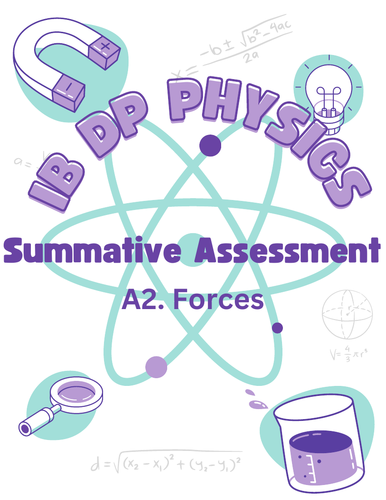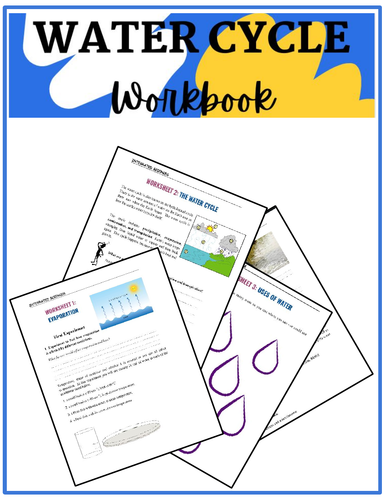5Uploads
589Views
14Downloads
All resources

IB DP Physics: A2.Forces Summative Assessment (+Answer Key)
The Summative Assessment for A2 Physics - Forces is a comprehensive evaluation tool designed to assess students’ understanding of fundamental concepts related to forces as per the new IB Physics curriculum. This assessment is thoughtfully structured into six sections, each with its own set of exercises to gauge students’ grasp of various aspects of forces and their applications. The assessment is aimed at providing a holistic evaluation of students’ knowledge and skills in the field of forces.
Sections and Exercises:
Analysing Forces
Friction Force
Buoyant Force
Hooke’s Law
Viscous Drag Force
Newton’s Laws of Motion
This assessment is designed to assess not only the theoretical knowledge of the students but also their ability to apply these concepts to solve problems and analyze physical situations. It encourages critical thinking, problem-solving, and a deep understanding of the principles of forces.
The Summative Assessment for A2 Physics - Forces aligns perfectly with the new IB Physics curriculum, ensuring that students are well-prepared for the challenges of the course.

MYP Maths: Exploring cubic functions and their transformations (Criteria B & C)
MYP Maths: Exploring cubic functions and their transformations
(Criteria B & C)
This activity is designed to foster critical thinking, mathematical reasoning, and communication skills.
This activity pack includes a detailed rubric and a carefully crafted worksheet, guiding students through a series of tasks. They’ll start by finding the values of a cubic function, plotting points, and analyzing the resulting graph. Students will describe the shape of the cubic function using essential mathematical terms such as increasing, decreasing, maximum, minimum, y-intercept, and x-intercept.
Furthermore, this resource extends the investigation by prompting students to consider modifications and transformations of the base cubic function. Students will explore potential alterations to the function to observe how these changes affect the graph’s characteristics.
To facilitate this exploration, the resource suggests the use of Desmos. Any online graphing tool can be used. Students will change the equations and visualize transformations, thereby deepening their understanding of how variations impact the graph of a cubic function.
This resource is ideal for middle and high school mathematics classes, serving as an engaging supplement to the curriculum while promoting critical thinking, graphing skills, and analytical reasoning. It aligns with Criteria B (Investigating Patterns) and Criterion C (Communicating) of the MYP Mathematics and includes a rubric for easy assessment of student progress and understanding.

Water Cycle: Workbook
This comprehensive workbook focuses on the Water Cycle and its various aspects. This engaging resource comprises four worksheets designed to immerse learners into the fundamental concepts of water science.
The journey begins with the ‘Evaporation Explorations’ worksheet, featuring two captivating practical activities. Students will uncover the mechanisms behind this essential phase of the water cycle through hands-on experiments, fostering a deeper understanding of how water transitions from liquid to vapor.
The subsequent worksheet, 'Water Cycle, provides a comprehensive overview of the water cycle itself. Engaging visuals, concise explanations, and interactive elements guide students through the stages of precipitation, condensation, evaporation, and runoff. This section encourages critical thinking by prompting learners to connect each stage and understand the cyclical nature of water on our planet.
Moving forward, the workbook delves into ‘The Uses of Water,’ shedding light on the diverse applications of this precious resource. Learners will explore the significance of water in daily life, industry, agriculture, and beyond, fostering an appreciation for the multifaceted roles water plays in sustaining our world.
Finally, the ‘Treatment of Water’ section navigates through the essential processes involved in purifying water for various purposes. Students will gain insight into water treatment methods, emphasizing the importance of clean water for human consumption and ecological balance.

IB MYP Physics Summative Assessment/eAssessment prep/Exam: Waves and Movement
Overview:
This summative assessment worksheet on Waves and Movement is specifically designed to evaluate MYP4 or 5 students in preparation for their eAssessments or end-of-term exams. Spanning across three MYP Science criteria (Criteria A, B, and C), this assessment combines theoretical understanding, problem-solving, and experimental design to comprehensively assess students’ knowledge and skills on waves and movement.
Criterion A - Theoretical Understanding:
Question 1: Evaluate students’ ability to calculate essential motion parameters (distance, displacement, velocity) of an object moving along a straight horizontal line. This question assesses their grasp of fundamental kinematic concepts.
Question 2: Assess students’ proficiency in wave analysis by labeling parts of waves and comparing characteristics such as wavelength and amplitude.
Question 3: Evaluate comprehension of graphical representations of waves by extracting parameters like wavelength, amplitude, frequency, and speed. This question tests students’ ability to interpret graphical data.
Question 4: Measure students’ ability to convert units and apply them to solve real-world problems, as they convert speed from km/h to m/s and determine distances covered over specific time periods.
Criteria B and C - Experimental Design:
Designing an Experiment: Challenge students to create an experiment focusing on measuring the loudness of sound waves. This segment assesses their experimental design skills, including defining variables, formulating hypotheses, creating data tables, and using patterns to predict values.
Purpose:
Prepares students for their MYP eAssessments or final exams by addressing essential concepts and skills in Waves and Movement.
Promotes critical thinking, problem-solving, and experimental design skills required for scientific inquiry.
Offers a comprehensive evaluation across multiple dimensions of learning, including theory, practical application, and analytical reasoning.

IB DP Physics Worksheet: Collisions in one and two dimensions (Topic A4)
This worksheet is designed for students studying IB DP Physics, focusing on the principles of kinetic energy and momentum in collisions. The worksheet covers both one-dimensional and two-dimensional collisions, providing a holistic understanding of these fundamental concepts.
Content Overview:
Introduction:
Brief overview of the conservation of momentum in collisions.
Differentiation between elastic and inelastic collisions.
Explanation of kinetic energy conservation or loss during collisions.
Theory and Formulas:
Summarized information table on collisions, momentum, and kinetic energy.
Derivation of a formula relating kinetic energy and momentum
Exercises on 1D collisions and explosions.
Three engaging problems involving explosion and collision scenarios.
Exploration of different collision scenarios, requiring the calculation of speeds, directions, and kinetic energy ratios.
Application of principles to real-world situations, such as a firecracker explosion and plastic sphere collision.
Additional Challenge:
Scenario involving a cart with changing mass, requiring students to determine forces, power, and the rate of change of kinetic energy.
Two-Dimensional Collisions:
Introduction to two-dimensional collisions.
Diagram and instructions for solving problems involving momentum conservation in both x and y directions.
Exercises on two-Dimensional collisions:
Two problems involving two-dimensional collisions, enhancing problem-solving skills.
Calculation of final speeds and determination of collision type (elastic or inelastic).
If you find this product helpful, please take a moment to rate it! Your feedback is greatly appreciated!





